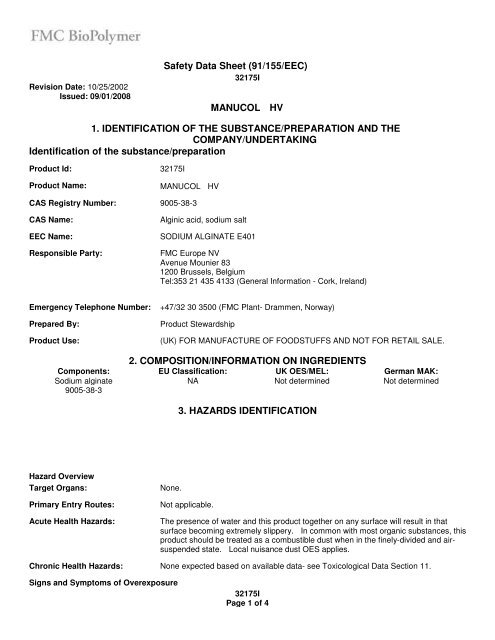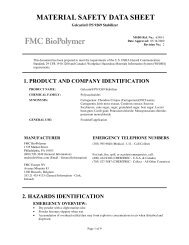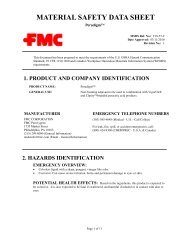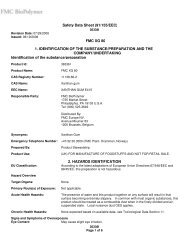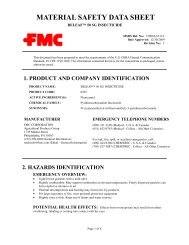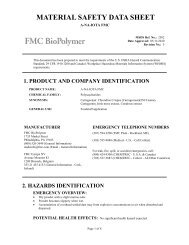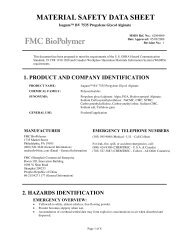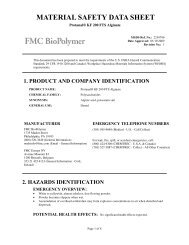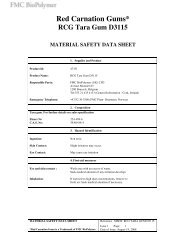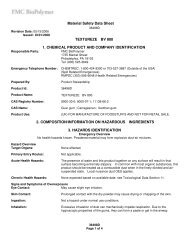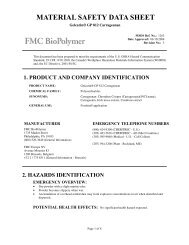MANUCOL HV 1. IDENTIFICATION OF THE SUBSTANCE ...
MANUCOL HV 1. IDENTIFICATION OF THE SUBSTANCE ...
MANUCOL HV 1. IDENTIFICATION OF THE SUBSTANCE ...
You also want an ePaper? Increase the reach of your titles
YUMPU automatically turns print PDFs into web optimized ePapers that Google loves.
Revision Date: 10/25/2002<br />
Issued: 09/01/2008<br />
Safety Data Sheet (91/155/EEC)<br />
32175I<br />
<strong>MANUCOL</strong> <strong>HV</strong><br />
<strong>1.</strong> <strong>IDENTIFICATION</strong> <strong>OF</strong> <strong>THE</strong> <strong>SUBSTANCE</strong>/PREPARATION AND <strong>THE</strong><br />
COMPANY/UNDERTAKING<br />
Identification of the substance/preparation<br />
Product Id: 32175I<br />
Product Name: <strong>MANUCOL</strong> <strong>HV</strong><br />
CAS Registry Number: 9005-38-3<br />
CAS Name: Alginic acid, sodium salt<br />
EEC Name: SODIUM ALGINATE E401<br />
Responsible Party: FMC Europe NV<br />
Avenue Mounier 83<br />
1200 Brussels, Belgium<br />
Tel:353 21 435 4133 (General Information - Cork, Ireland)<br />
Emergency Telephone Number: +47/32 30 3500 (FMC Plant- Drammen, Norway)<br />
Prepared By: Product Stewardship<br />
Product Use: (UK) FOR MANUFACTURE <strong>OF</strong> FOODSTUFFS AND NOT FOR RETAIL SALE.<br />
2. COMPOSITION/INFORMATION ON INGREDIENTS<br />
Components: EU Classification: UK OES/MEL: German MAK:<br />
Sodium alginate<br />
9005-38-3<br />
NA Not determined Not determined<br />
Hazard Overview<br />
Target Organs: None.<br />
Primary Entry Routes: Not applicable.<br />
3. HAZARDS <strong>IDENTIFICATION</strong><br />
Acute Health Hazards: The presence of water and this product together on any surface will result in that<br />
surface becoming extremely slippery. In common with most organic substances, this<br />
product should be treated as a combustible dust when in the finely-divided and airsuspended<br />
state. Local nuisance dust OES applies.<br />
Chronic Health Hazards: None expected based on available data- see Toxicological Data Section 1<strong>1.</strong><br />
Signs and Symptoms of Overexposure<br />
32175I<br />
Page 1 of 4
Eye Contact: May cause mild eye irritation.<br />
Skin Contact: Prolonged contact with the dry powder may cause drying or chapping of the skin.<br />
Ingestion: Not a hazard under normal use conditions.<br />
Inhalation: Excessive inhalation of dust can mechanically impede respiration. Due to the<br />
hygroscopic properties of the gums, they can form a paste or gel in the airway.<br />
4. FIRST AID MEASURES<br />
Eye Contact: Flush with copious amounts of water.<br />
Skin Contact: Wash with soap and water.<br />
Ingestion: Do not induce vomiting. Slowly dilute with 1-2 glasses of water or milk and seek<br />
medical attention. Never give anything by mouth to an unconscious person.<br />
Inhalation: If inhaled, remove to fresh air. If not breathing or if breathing is difficult, give artificial<br />
respiration or oxygen by trained personnel. Seek medical attention.<br />
5. FIRE-FIGHTING MEASURES<br />
Flash Point (°F): N.Ap.<br />
Extinguishing Media: Alcohol foam/ Dry chemical/ Carbon dioxide / Water<br />
Unusual Fire/Explosion Hazards: Powdered material may form explosive dust-air mixtures.<br />
Special Protective Equipment: Fire fighters should wear full protective clothing, including self-contained breathing<br />
equipment.<br />
Personal Precautionary<br />
Measures:<br />
Procedure for<br />
Cleaning/Absorption:<br />
6. ACCIDENTAL RELEASE MEASURES<br />
Use appropriate protective equipment.<br />
Scoop up and remove. Minimize dust generation and accumulation. Water<br />
washdown not recommended.<br />
7. HANDLING AND STORAGE<br />
Handling: Minimize dust generation and accumulation. Wash thoroughly with soap and water<br />
after handling.<br />
Storage: Store in a cool, dry place, out of direct sunlight. Hygroscopic Material. Keep<br />
containers closed tightly when not in use.<br />
8. EXPOSURE CONTROLS / PERSONAL PROTECTION<br />
Engineering Controls: Use in a well ventilated area.<br />
Respiratory Protection: Local nuisance dust OES applies. Use in a well ventilated area. An approved<br />
respirator (i.e. NIOSH, etc.) should be worn when exposures are expected to exceed<br />
the applicable limits.<br />
Hand Protection: Use gloves as a standard industrial handling procedure.<br />
Eye Protection: Safety glasses.<br />
32175I<br />
Page 2 of 4
9. PHYSICAL AND CHEMICAL PROPERTIES<br />
Physical State: Powder<br />
Color: White / Yellowish brown<br />
Odor: Slight<br />
pH: ~Neutral (1% solution)<br />
Boiling Point (°F): Not determined<br />
Melting Point/Freezing Point(°F): Not determined<br />
Vapor Pressure: Not determined<br />
Solubility: Soluble in water<br />
10. STABILITY AND REACTIVITY<br />
Chemical Stability: Stable under normal conditions of handling, use and transportation.<br />
Hazardous Polymerization: Will not occur<br />
Conditions to Avoid: Minimize dust generation and accumulation.<br />
Materials to Avoid: Strong oxidizers.<br />
Hazardous Decomposition<br />
Products:<br />
Toxicity Test:<br />
Acute Oral LD50 (mg/kg): >5,000 (rat)<br />
Acute Inhalation LC50 (mg/l): >4.7 (1hr.) (rat)<br />
Carbon dioxide. Carbon monoxide.<br />
1<strong>1.</strong> TOXICOLOGICAL INFORMATION<br />
Skin Irritation: Non-irritating to rabbit skin.<br />
Eye Irritation: Non-irritating to rabbit eye.<br />
Other Information: Chronic Oral, Rat: No adverse effects at dosage levels up to 5% of the diet.<br />
Chronic Oral, Dog: No adverse effects at dosage levels up to 15% of the diet.<br />
12. ECOLOGICAL INFORMATION<br />
Biodegradability: Sodium alginate is biodegradable: BOD5: ~300 mg O2/g; COD: ~660 mg O2/g<br />
Aquatic Toxicity: No data is available on the adverse effects of this material on the environment.<br />
13. DISPOSAL CONSIDERATIONS<br />
Disposal of Waste Method: Follow all applicable community, national or regional regulations regarding waste<br />
management methods.<br />
14. TRANSPORT INFORMATION<br />
Hazard Classification: This product is non-hazardous, and no special precautions require to be taken in<br />
connection with transportation.<br />
Classification:<br />
15. REGULATORY INFORMATION<br />
32175I<br />
Page 3 of 4
This product is not classified as hazardous under the terms of the EEC directive 67/548/EEC, UN regulations or the<br />
European ADR/RID agreements.<br />
TSCA Inventory List: This product and/or its components is listed on TSCA.<br />
California Proposition 65<br />
Carcinogens & Reproductive<br />
Toxicity (CRT) List:<br />
None of the components of this product is listed on CALPROP.<br />
Canada DSL Inventory List: This product and/or its components is listed on DSL.<br />
Canada NDSL Inventory List: This product and/or its components is not listed on NDSL.<br />
EU EINECS List: This product and/or its components is not listed on or is exempt from EINECS.<br />
ELINCS: This product and/or its components is not listed on ELINCS.<br />
Germany VCI Assigned This product and/or its components is not listed on WGK.<br />
Classification into Water<br />
Endangering Classes (WGK) List:<br />
Japan Inventory of Existing &<br />
New Chemical Substances<br />
(ENCS):<br />
Australia Inventory of Chemical<br />
Substances (AICS) List:<br />
This product and/or its components is listed on ENCS.<br />
This product and/or its components is listed on AICS.<br />
Food Approvals: Food Grade Sodium alginate is affirmed as a "Generally Recognized as Safe" GRAS<br />
under the US FDA (21 CFR 184.1724).<br />
16. O<strong>THE</strong>R INFORMATION<br />
Prepared By: Product Stewardship<br />
Legend: N.Av.= Not Available; N.Ap.= Not Applicable<br />
Important Note: The information contained in this document (as well as any advice or assistance)<br />
is provided by FMC only as a courtesy and is intended to be general in nature.<br />
Any uses suggested by FMC are presented only to assist our customers in exploring<br />
possible applications. FMC makes no warranty, express or implied, as to its<br />
accuracy or completeness, or the results to be obtained from such information,<br />
advice or assistance. Each customer is solely responsible for determining whether<br />
the FMC products are suitable for such customer’s intended use, and for obtaining any<br />
necessary governmental registrations and approvals for such customer’s production,<br />
marketing, sale, use and/or transportation of finished goods using or incorporating the<br />
FMC products.<br />
***END <strong>OF</strong> MSDS***<br />
32175I<br />
Page 4 of 4


